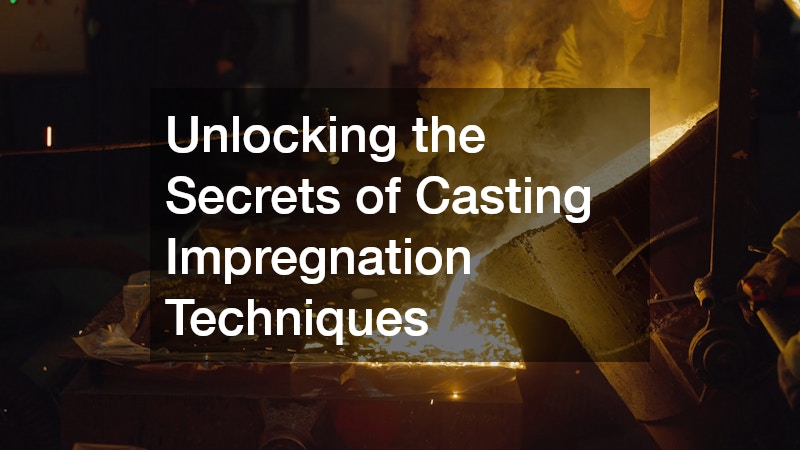
Casting impregnation techniques are innovative processes used within the manufacturing industry to enhance the quality, performance, and longevity of cast products. These techniques hold substantial significance as they strategically improve the material properties of cast components, which are extensively used across different sectors such as automotive, aerospace, and industrial manufacturing. Understanding and implementing these techniques can lead to significant advancements in product durability and reliability, ensuring heightened satisfaction for end-users and a potential reduction in production costs.
What is Casting Impregnation and Why is it Important?
Casting impregnation refers to the process of treating porous castings with sealants to fill surface-connected porosities, thereby improving their performance and durability. It is crucial in maintaining the integrity of cast components, as it prevents common issues like leaks and structural weaknesses, which could potentially lead to catastrophic failures in their applications. The importance of casting impregnation is underscored by its ability to transform materials that may be deemed otherwise unusable into robust, reliable components ready for high-stakes applications.
The basic mechanism of casting impregnation involves the infiltration of sealants into the microscopic pores of a cast part under controlled conditions, typically using vacuum or pressure techniques. The process is meticulously calibrated to ensure thorough penetration and curing of the sealant within the pores, effectively sealing them and preventing potential pathways for leakages. These meticulous procedures are crucial as they significantly enhance the integrity and utility of the cast component, making casting impregnation a vital step in the production process for industries demanding high precision and quality standards.
How Does Casting Impregnation Improve Material Properties?
Through the effective sealing of microscopic pores, casting impregnation substantially enhances the mechanical and physical properties of cast components, making them more suitable for demanding environments. The impregnation process contributes to increased tensile strength and fatigue resistance, crucial factors for components subjected to constant mechanical stress. Additionally, by fortifying the material against the permeation of fluids and gases, casting impregnation ensures improved resilience and reliability in harsh operational settings, thereby extending the service life of these components. This makes it an essential step in quality assurance for industries such as automotive, aerospace, and heavy machinery, where consistent performance under pressure is non-negotiable.
The most outstanding benefit of casting impregnation is the increase in material strength, which makes cast components more resilient against physical and environmental stressors. Durability is another significant enhancement, where impregnated materials exhibit prolonged lifespans, thereby reducing the frequency of replacements needed and leading to cost-efficiency. Furthermore, impregnated components acquire superior resistance to corrosion and chemical attack, enhancing their usability in chemically aggressive environments and contributing to better overall performance and longevity.
What are the Different Methods of Casting Impregnation?
There exist several methods of casting impregnation, each tailored to effectively address different types of porosity and material demands. The most prevalent among these are vacuum impregnation, pressure impregnation, and vacuum-pressure methods, all of which offer distinct advantages based on their operational contexts. Selecting the appropriate method is usually dictated by the specific requirements of the cast material and the levels of quality control demanded by the end application, underscoring the importance of technical expertise in these procedures.
Among the primary methods, vacuum impregnation is praised for its efficacy in thoroughly sealing micro-porosities by evacuating air before the introduction of sealant, making it ideal for small and intricate components. On the other hand, pressure impregnation relies on the application of external pressure to force the sealant into the pores, making it suitable for larger surfaces where air evacuation may be impractical. Vacuum-pressure impregnation combines these two techniques to maximize penetration and sealing effectiveness, thereby offering an optimal solution for components demonstrating a blend of porosity challenges.
What Challenges are Associated with Casting Impregnation?

Casting impregnation presents several challenges, primarily rooted in the complexity of adequately penetrating and sealing every porous region within the material. There are instances where incomplete impregnation occurs, particularly with complex-shaped components and those with varied pore sizes, leading to potential operational failures. Furthermore, the compatibility between the sealant and the material, alongside the environmental considerations of applying such techniques, can present obstacles that necessitate careful resolution to ensure reliable outcomes and environmental compliance.
To effectively address these challenges, advanced diagnostic techniques, such as non-destructive testing, are employed to accurately identify and assess porosity levels before treatment. Adopting meticulously controlled impregnation protocols helps to ensure uniform sealant distribution and comprehensive penetration into all porous regions. Innovations in sealant formulations are also instrumental in overcoming compatibility challenges, as they offer specialized solutions tailored to the specific material characteristics and performance expectations of the industry.
Casting impregnation techniques are vital in enhancing the quality and performance of cast materials, offering numerous benefits such as increased strength, durability, and corrosion resistance. While challenges exist, strategic approaches and technological innovations continue to advance the efficiency and reliability of these methods. As the industry moves forward, further developments in impregnation technologies promise to refine these processes, ensuring that cast products meet the ever-evolving needs of modern engineering applications.
